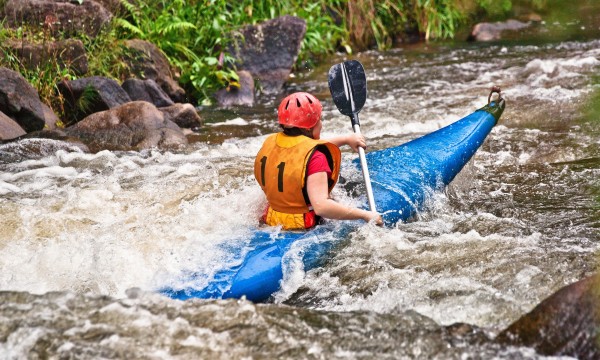To run a river successfully, you must be able to read the water as though it were a book — observing its features, interpreting what they mean and knowing how to handle them. Canoeists' maps are available that reveal a river's special features and rate their difficulty, but the real interpretation must be done on the spot. For this task there is no substitute for experience, good judgment and a cool head.
- Browse Categories
- All Tips
-
Home & Garden
- All
- Appliances
- Bathroom
- Cleaning
- Crafts
- Decorating
- Electrical
- Flooring
- Furniture
- Garage Door
- Gardening
- Green Living
- Heating
- Home Alarm Systems
- Home Maintenance
- Home Remedies
- Home Security
- Home Staging
- House Sitting
- Junk Removal
- Kitchen
- Lawn Care
- Lock Systems
- Moving
- Outdoor Living
- Pest Control
- Plumbing
- Renovation
- Roofing
- Snow Removal
- Storage
- Tools
- Tree Service
- Health
- Family
- Travel
- Auto
- More Tips
Your account is now active!

Navigating the river: safe tips for canoeing and kayaking
July 29, 2015

12 things to know about rivers
- Make sure you have easy access to the water.
- Carry your canoe around falls or rapids that are beyond your ability.
- Stopper (also called keeper) waves, ones that revolve back on themselves and can trap your vessel, may be caused by a ledge, an overflowed dam or a submerged obstacle.
- A "V" is a signpost in a river. Pointing downstream, Vs usually show the way to clear, safe water between rocks.
- The deepest — and fastest — channel is usually on the outside of a bend.
- Shallows usually form on the inside of a bend.
- Look out for low-hanging branches.
- Let the current carry your stern out in a curve and point your bow in the right direction, then paddle with the current.
- A combination draw and push stroke moves the canoe sideways while keeping it parallel with the current.
- Eddies, relatively placid pools amid strong main currents, appear behind rocks and other obstacles. Pulling into an eddy is a good way to stop to scout the best channel to follow. Getting across the eddy line — the meeting of fast and slow water — requires care and skill.
- Pointing upstream, Vs mark visible or submerged obstacles. Pull out well before you encounter this kind of obstacle.
- Know the river before you canoe it. Buy a map. Best of all, go with someone who has canoed the waterway before.
Avoiding obstacles
When faced with an obstacle, use a draw stroke to push water under the side of the canoe, moving it sideways.
- Contrary to what you might expect, the stroke tilts the boat away from the paddle. This ploy is also useful in counteracting cross-currents.
How you can right a canoe
- A low brace, or slap support, stroke rights the boat rapidly, stopping a capsize. Lean over the gunwale on the side tilting downwards and push down quickly with the paddle, at the same time pivoting your lower body to swing the boat upright.
- Practising the stroke is very important, as it may be difficult at first to get the timing of the paddle and lower body movements right; a common fault is to slap at the water without really leaning the canoe over.
- The low brace stroke has many applications, but it is essential for turning into or out of eddies.
Hazards beneath the surface
Stoppers, pillows and haystacks are signs of hidden obstacles.
- A swift current flowing over a deep hole produces a stopper wave that can upset and trap a canoe; it is best to avoid it, but if you feel confident enough of your skills, meet it at a slight angle with speed to carry through.
- A pillow — a smooth surface hump — indicates a rock below and should be paddled around.
- Haystacks are a more welcome sight; they are standing waves that form when swift water slows, and usually provide a safe, exciting ride.
Canoeing and kayaking can be a lot of fun if you know where you're going. Keep these safety tips in mind and learn how to navigate on the open water.
National advertising powered by Mediative.com. Yellow PagesTM, Walking Fingers & DesignTM, YP.caTM, Find. & DesignTM, YellowPages.caTM, Canada411TM and YP ShopwiseTM are trademarks of Yellow Pages Digital & Media Solutions Limited in Canada. All other trademarks are the property of their respective owners. Copyright © 2018 Yellow Pages Digital & Media Solutions Limited. All Rights Reserved.
More Tips
The material on this website is provided for entertainment, informational and educational purposes only and should never act as a substitute to the advice of an applicable professional. Use of this website is subject to our terms of use and privacy policy.






